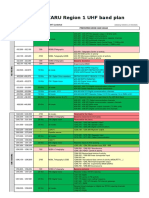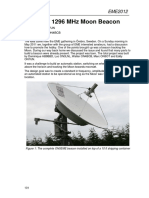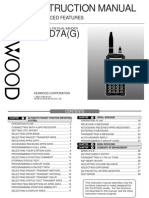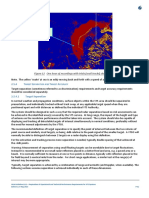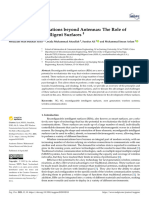An Introduction to APRS
Presented by Scott Grimmett
What is APRS?
APRS stands for Automatic Packet Reporting System (although it is frequently also called Automatic Position Reporting System.) APRS can be used to track an object using a amateur radio and a GPS receiver. The position location information can be viewed on internet websites.
2
�APRS Applications
Typical applications are:
Marathons, races, events and public service Search and rescue Family tracking Weather data exchange and display
APRS Hardware
APRS needs three pieces of hardware
GPS
Terminal Node Controller (TNC)
Transceiver
4
�GPS Global Positioning System
A standard GPS unit with data output port. Uses 24 orbiting satellites to pinpoint anyone's specific geographic location. GPS also provides ground speed and altitude measurements.
5
TNC Terminal Node Controller
A TNC which is basically a radio (or RF) modem. The TNC connects the GPS to the transceiver. It converts the GPS data into AX.25 Packet protocol to send via the transceiver.
�APRS Transceiver
A VHF Amateur Radio Transceiver operating on 144.390 MHz. (USA). Should be a transceiver as APRS uses a collision detection system to know when to send data. Range of coverage depends on the power of the transmitter and terrain.
7
Radios with Built-in TNCs
These radios are specifically designed to support APRS functions in a single package. Just add a basic GPS unit and it is ready.
Kenwood TM-D700A Kenwood TH-D7A Alinco DR-135T MKII with EJ-41U TNC
8
�Built-in TNC configuration
GPS
Transceiver
9
APRS TNCs
This full featured Kantronics TNC can both transmit and receive. TinyTracs are simple Transmit Only stand alone APRS TNCs.
10
�APRS TNCs
This full featured Kantronics TNC can both transmit and receive. TinyTracs are simple Transmit Only stand alone APRS TNCs.
11
APRS Hardware
GPS Receiver
Terminal Node Controller (TNC)
Transceiver
12
�APRS Weather Stations
In a APRS weather station the GPS unit is replaced by an outside Weather Station.
Weather Station
Terminal Node Controller (TNC)
Transceiver
13
How does the signal travel?
Digipeater APRS System Internet Gateway
Internet
14
�Use the internet to plot location
15
Plot Location
16
�Track Objects
17
Show APRS Activity in an Area
18
�What is APRS. APRS receiver (GPS, TNC, Radio) APRS Mapping Software My system Track this week Bike event tracking Radios with TNC built in Other APRS systems. How signal travels Weather
19
APRS
APRS needs three pieces of hardware:
A Transceiver A Terminal Node Controller TNC A GPS receiver
20
10
�Radios with built in TNCs
These radios are specifically designed to support APRS functions in a single package. Just add a basic GPS unit and it is ready.
Kenwood TM-D700A (includes front panel display) Kenwood TH-D7A (includes front panel display) Alinco DR-135T MKII with EJ-41U TNC
21
APRS Weather Stations
In a APRS weather station the GPS unit is replaced by an outside Weather Monitoring Station.
22
11
�Gateway Station
An amateur radio station used to connect other amateur radio stations to the internet is called a gateway.
Gateway
Internet
23
It uses graphical maps and other data displays. All communications use a one-to-many protocol so everyone is updated in real time. Uses Generic digipeating so knowledge of the network isnt required. APRS turns packet radio into a real-time tactical communications and display system for emergencies and public service applications.
24
12
�APRS consists of a very large land based wireless network. Almost 30,000 users around the world. This network works via RELAYS every 20-30 miles called digipeaters. And Globally via IGates to the internet. APRS is also used via some of the Amateur Satellites. It is also used to monitor telemetry values of weather stations for the National Weather Service (NWS) APRS has the capability to quickly relay telemetry values to research centers without the Internet.
25
13








































